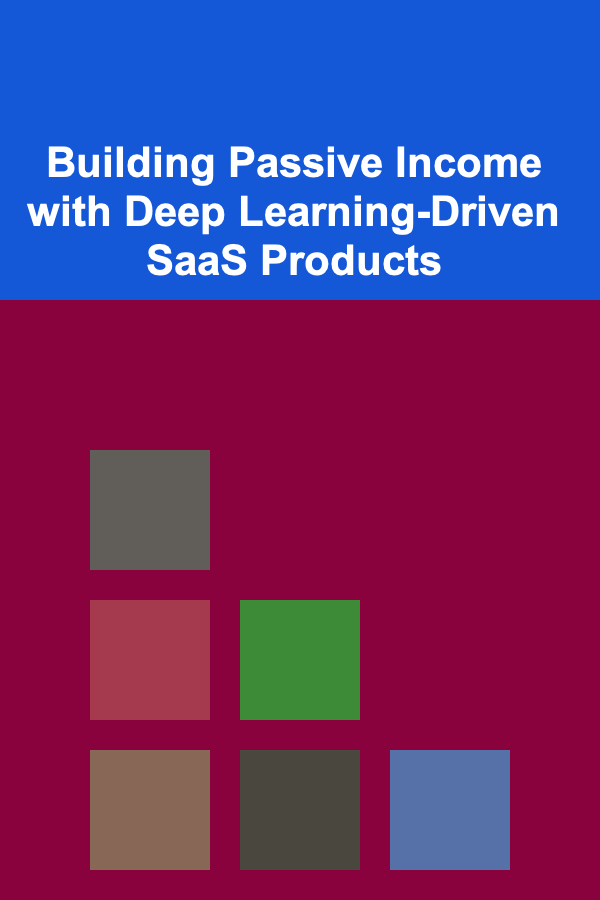
Building Passive Income with Deep Learning-Driven SaaS Products
ebook include PDF & Audio bundle (Micro Guide)
$12.99$8.99
Limited Time Offer! Order within the next:

In today's fast-paced digital world, artificial intelligence (AI) and machine learning (ML) are shaping the future of businesses, from healthcare to finance and beyond. Within AI, deep learning---a subset of machine learning---is at the forefront of some of the most cutting-edge innovations. With its ability to process vast amounts of unstructured data and perform tasks like speech recognition, image processing, and even complex decision-making, deep learning has opened up numerous avenues for entrepreneurs to build profitable businesses.
One of the most attractive ways to leverage deep learning is by developing Software as a Service (SaaS) products. SaaS, a cloud-based model where users pay for access to software hosted online, has become one of the most effective and scalable business models in recent years. When integrated with deep learning, SaaS products have the potential to generate passive income for their creators. In this article, we will explore how to build passive income with deep learning-driven SaaS products, focusing on the various business models, the process of developing deep learning solutions, and the strategies that can ensure sustained revenue.
Understanding Deep Learning and SaaS
Before diving into how deep learning-driven SaaS products can generate passive income, it's crucial to understand both deep learning and the SaaS model in more depth.
What is Deep Learning?
Deep learning is a type of machine learning that uses artificial neural networks with many layers to simulate the behavior of the human brain in processing data. This technique allows computers to learn from large amounts of data, identifying patterns and making decisions with minimal human intervention. Deep learning algorithms have made groundbreaking strides in areas such as:
- Natural Language Processing (NLP): Powering voice assistants, chatbots, and automated translations.
- Computer Vision: Enabling image recognition, facial recognition, and autonomous vehicles.
- Reinforcement Learning: Used in robotics and autonomous systems where machines learn by interacting with an environment.
- Predictive Analytics: Enhancing decision-making in business, healthcare, and finance by forecasting trends, customer behavior, or medical conditions.
The primary advantage of deep learning lies in its ability to perform complex tasks without explicitly being programmed for each one, making it ideal for SaaS products that require continuous learning and adaptation.
What is SaaS?
Software as a Service (SaaS) is a cloud-based software distribution model where users access software through the internet. Unlike traditional software, which is sold as a one-time license, SaaS products are usually offered through a subscription model. SaaS has several advantages:
- Scalability: SaaS products can easily be scaled to meet growing demand, making them ideal for businesses that want to grow without the need for substantial upfront investments.
- Accessibility: SaaS products are hosted in the cloud, meaning users can access them from anywhere with an internet connection.
- Continuous Updates: SaaS businesses can offer continuous improvements and updates without requiring users to manually upgrade their software.
- Subscription Revenue Model: SaaS products often employ a recurring subscription model, which provides businesses with a predictable and sustainable stream of revenue.
Combining deep learning with SaaS allows for powerful, adaptive solutions that continually improve over time. By creating a deep learning-driven SaaS product, you can build a business with recurring revenue that leverages the power of artificial intelligence.
How to Build Deep Learning-Driven SaaS Products for Passive Income
Building a deep learning-driven SaaS product for passive income is a multi-step process that requires a combination of technical expertise, business acumen, and strategic planning. Below are the essential steps involved in developing such a product:
2.1. Identifying Market Needs and Target Audience
Before diving into development, it's crucial to identify a specific market need that can be addressed with deep learning. While deep learning is powerful, it's important to apply it where it adds tangible value. Some questions to ask during this phase include:
- What problems can deep learning solve in specific industries or domains?
- What are the pain points of businesses or individuals that can be addressed with automation or advanced prediction models?
- Is there enough data to train a deep learning model that can solve the problem effectively?
A few examples of potential areas where deep learning-powered SaaS products can create passive income include:
- Automated Image Recognition for E-commerce: A service that uses deep learning to categorize and tag images of products on e-commerce platforms.
- Predictive Analytics for Healthcare: A SaaS product that uses deep learning to predict patient outcomes or recommend treatments based on medical data.
- AI-Powered Customer Support Chatbots: A chatbot that can understand and respond to customer queries using natural language processing.
Once a market need has been identified, it's essential to define the target audience and understand their specific needs, willingness to pay, and the type of user experience they expect.
2.2. Building the Deep Learning Model
Once the market and problem have been identified, the next step is to build the deep learning model that will power your SaaS product. This phase involves:
- Data Collection: The quality of your model depends heavily on the data used for training. You need to collect and preprocess large amounts of relevant data. This could include publicly available datasets, proprietary data from businesses, or data that you collect through surveys or direct partnerships.
- Choosing the Right Algorithm: Depending on the problem you're solving, you'll need to choose the appropriate deep learning architecture. For example, Convolutional Neural Networks (CNNs) are commonly used for image processing, while Recurrent Neural Networks (RNNs) or Transformers are better suited for natural language processing.
- Model Training and Evaluation: Once the data is prepared, you'll train your model. Deep learning models require significant computational resources, which means using powerful hardware like GPUs or TPUs. During training, it's important to evaluate the model's accuracy, overfitting, and other performance metrics to ensure that the model performs well.
- Optimization: Fine-tuning and optimizing your deep learning model for performance, scalability, and cost efficiency is crucial, especially when deploying it as a SaaS product. This could involve pruning models, reducing the computational overhead, and selecting the right framework for deployment (TensorFlow, PyTorch, etc.).
2.3. Developing the SaaS Platform
Once the deep learning model is ready, you need to integrate it into a SaaS platform that is user-friendly, scalable, and secure. Key components of this phase include:
- Building the User Interface (UI): The user interface should be intuitive and easy to navigate. Even though deep learning is a complex field, the end-user experience should be simple and accessible. For example, users shouldn't need to understand the intricacies of deep learning to use your product effectively.
- Backend Development: The backend of your SaaS product will handle the heavy lifting, including running the deep learning models, managing user data, and handling subscriptions. You'll likely use a cloud service provider (e.g., AWS, Google Cloud, or Azure) to host your models and databases.
- Integration with Third-Party Services: To add more value to your SaaS product, you can integrate with other services, such as payment gateways, customer relationship management (CRM) systems, or analytics platforms.
- Security and Compliance: Data security and user privacy are top priorities in SaaS. Ensure that your platform complies with relevant regulations, such as GDPR for European customers or HIPAA for healthcare data.
2.4. Setting Up a Monetization Model
The beauty of SaaS products is that they can provide a steady stream of income, and deep learning can add value to various monetization models. Below are a few options:
- Subscription-Based Model: Offer a recurring subscription plan where users pay monthly or annually to access your product. You can create tiered pricing plans based on usage, number of users, or features.
- Freemium Model: Provide a basic version of your SaaS product for free, with limited features or usage, and offer premium features for a paid subscription. This model works well to attract users and then convert them to paying customers over time.
- Pay-Per-Use Model: Charge users based on how much they use your deep learning-powered service. This could be based on API calls, data processed, or transactions completed. This model works well for products that may have variable usage rates.
- License Fees: Offer a one-time licensing fee for large organizations to use your deep learning model internally. This model can generate a significant upfront payment but may not be as scalable as subscription models.
2.5. Marketing and Customer Acquisition
Once your SaaS product is ready, the next step is to get it into the hands of potential customers. Marketing your deep learning-driven SaaS product requires a combination of digital marketing strategies, including:
- Content Marketing: Create valuable content that highlights the benefits of deep learning and how your SaaS product solves specific problems. Blog posts, case studies, webinars, and whitepapers are great tools to build awareness.
- Search Engine Optimization (SEO): Optimize your website and content for search engines so that potential customers can find your product easily.
- Paid Advertising: Consider using paid ads on platforms like Google, Facebook, or LinkedIn to target your ideal customer profile.
- Referral Programs: Implement referral programs to incentivize existing users to bring in new customers.
2.6. Automating Operations for Passive Income
To truly make your deep learning-driven SaaS product a source of passive income, you need to automate as many processes as possible. This includes:
- Customer Support Automation: Use AI-powered chatbots to handle common customer inquiries and issues, reducing the need for a large support team.
- Billing and Subscription Management: Automate billing processes and ensure that customers are billed correctly and consistently.
- Marketing Automation: Set up automated email campaigns, social media posts, and follow-ups to nurture leads and convert them into paying customers.
- Model Retraining and Updates: Implement processes for automatic model retraining and updates to ensure that the product continually improves without requiring constant manual intervention.
The Road Ahead
Building passive income with deep learning-driven SaaS products is an exciting and lucrative opportunity. However, it requires careful planning, consistent effort, and the ability to adapt to new technologies and market changes. By identifying the right problem to solve, building scalable and high-performing deep learning models, and creating an effective SaaS platform, entrepreneurs can unlock the potential of AI to generate long-term, sustainable income.
As deep learning continues to evolve and expand into new industries, the opportunities for monetizing these technologies through SaaS will only grow. Whether you're a data scientist, entrepreneur, or developer, now is the perfect time to explore how deep learning can be used to create innovative SaaS products that deliver both value to customers and passive income to creators.
Reading More From Our Other Websites
- [Personal Care Tips 101] How to Use Cuticle Oil for Anti-Aging Benefits
- [Home Party Planning 101] How to Plan a Holiday Party at Home: Tips for a Festive Celebration
- [Home Storage Solution 101] How to Build DIY Storage Solutions for Every Room in Your Home
- [Personal Finance Management 101] How to Manage Your Finances as a Freelancer or Gig Worker
- [Organization Tip 101] How to Choose the Right Storage Solutions for Your Office
- [Metal Stamping Tip 101] Avoiding Common Pitfalls: Best Practices for Maintaining Consistency in High‑Volume Metal Stamping Operations
- [Home Renovating 101] How to Negotiate Prices with Home Improvement Suppliers
- [Home Lighting 101] How to Create Professional Studio-Quality Lighting for Makeup Application on a Budget
- [Home Maintenance 101] How to Keep Your Home's Fireplace in Working Order
- [Home Budget 101] How to Budget for Pet Adoption and Ensure a Smooth Transition

How to Build a Strong Brand for Your Pet Supplies Dropshipping Store
Read More
How to Have a Family Dance-Off and Get Active Together
Read More
How to Make Money Online as a Meditation Coach: 10 Actionable Ideas
Read More
How to Manage Finances During Major Life Transitions
Read More
How to Protect Your Business from Cyber Attacks (Small Business Edition)
Read More
How to Discover the Legend of Bigfoot: Myth vs. Reality
Read MoreOther Products

How to Build a Strong Brand for Your Pet Supplies Dropshipping Store
Read More
How to Have a Family Dance-Off and Get Active Together
Read More
How to Make Money Online as a Meditation Coach: 10 Actionable Ideas
Read More
How to Manage Finances During Major Life Transitions
Read More
How to Protect Your Business from Cyber Attacks (Small Business Edition)
Read More